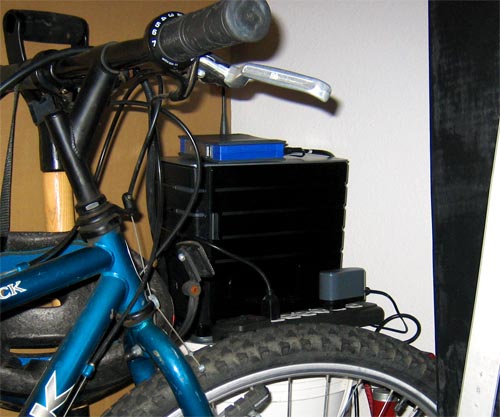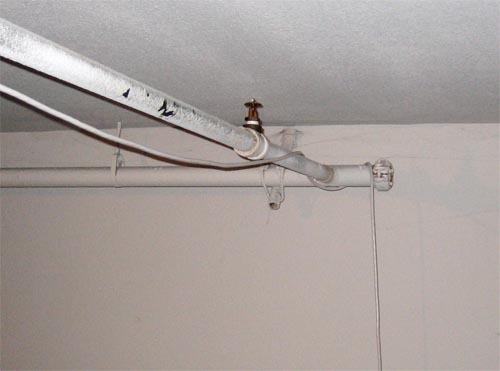Server noise
Unfortunately, after a couple of months of operation, my Windows Home Server has started to make a lot of noise. The case fans were always pretty loud, but now the hard disk has started making a high-pitched whining noise. Normally this wouldn't be too annoying since you could eventually get used to it, but the noises fluctuate in pitch at seemingly random intervals. This is irritating since you can't habituate to it and ignore it.
My first thought was to put it in the garage with a little Linksys WiFi bridge:

This worked pretty well and it certainly took care of the noise problem. Unfortunately it was a little far away from the AP, so the wireless connection went out every once in a while when doing things like using the microwave. It wouldn't normally really be noticeable, but it interrupted things like streaming music to the Squeezebox.
Another problem with the garage setup was that an outlet shortage forced me to run a power extension cable across the ceiling on a water pipe, right next to a fire sprinkler:

This was a disaster waiting to happen in more ways than one, and it also irked my inner-Electrical Engineer.
Now I'm trying a new solution, which is to stick the server in the laundry closet. This looks like it's working better so far (it's also a lot closer to the AP), but I'm waiting to see if it might overheat the closet or computer when the dryer is running.



February 10th, 2008 - 17:38
You should also try JungleDisk for windows home server and let us know how that works out. Basically it backs up your home server to Amazon S3. 😉
February 10th, 2008 - 19:13
Hmm, that is an interesting idea. Storing it on S3 looks pretty cheap.
But, my WHS is already the backup server, and I don’t need to backup the backup :). I’d really only need to do that if I was afraid of my apartment burning down and ruining all the disks, which seems unlikely.
February 10th, 2008 - 22:12
You could put it back in the garage and try a wired ethernet bridge, like this one (not that I recommend Netgear products): http://www.netgear.com/Products/PowerlineNetworking/PowerlineEthernetAdapters/XE102.aspx
I am still waiting for their wireless 110V AC power transmitter, though…
February 10th, 2008 - 22:13
Oops, broke your nice sidebar with my long link. 😉
February 10th, 2008 - 22:43
NOO you broke the sidebar!!
Hmm, I didn’t think about ethernet-over-power, but that would probably solve the WiFi range issue. I would still have the problem of the extension cord on the water pipe.
Also, the security-freak in me would be worried that my neighbors would have access to my network just by plugging into the AC main. I’m not really sure if that would work though – presumably it doesn’t work through the transformer that the power company uses to meter my apartment? Need to think about that…
February 11th, 2008 - 10:21
Have you tried just smacking the server?
February 11th, 2008 - 10:39
In general that usually makes it worse :). It might bump a fan back into alignment short-term, but it always comes back pretty soon afterward.
February 11th, 2008 - 15:10
Or you could always throw it out a window. It’s the recommended solution for computing problems at CU-boulder
February 11th, 2008 - 15:38
Do I know you?
February 12th, 2008 - 13:25
hey this has absolutely nothing to deal with your post, but i was assuming you know the answer to my question… partially because its from the back of a MS Business card, but mostly because you’re the man.
Can you solve this?
8bf3a13b 96acc949 5092c3b9 1e72c3b9
d426e032 c3b96acc 9495092c 3b9c2e43
bd28942c c2e4f563 b9cac3bd 28942c3b
499f563b 499f563b a43995f5 6395
February 12th, 2008 - 13:38
also becuase of MS
http://www.downloadsquad.com/2008/02/12/tired-of-getting-friend-requests-bill-gates-quits-facebook/
hilarious
February 12th, 2008 - 23:53
Yeah I can see why Bill would stop using Facebook. People keep posting stupid crap on his profile.
About the puzzle – hmm, that’s interesting. It’s apparently a Microsoft recruiting trick, so I probably can’t post the answer on the internet :). It’s interesting since there are several repeated sections, and one of them occurs on a 4-bit boundary, indicating that it’s probably not using a simple byte alphabet.
February 13th, 2008 - 11:47
I took a look last night and noticed the repeating sections also, but I am not so sure that one of them does indeed start on a 4-bit boundary. I think that could be just a coincidence given the 16 combinations possible in 4 bits. I do think an 8-bit boundary condition exists, though. I even tried to see if it was ARM or thumb assembly before I noticed the 8-bit boundary condition. 😉
February 13th, 2008 - 12:20
This is the sequence that repeats on a 4-bit boundary:
3b 96acc949 5092c3b9
It’s in both the first line and the second line, and it seems much too long to be a coincidence
February 13th, 2008 - 14:34
Oh, I see what you mean now, was getting confused with 4 and 8 bits. And I’m supposed to be a computer scientist. 🙁 Yeah, the long repeated section is odd, given the 4-bit alignment.
February 13th, 2008 - 15:52
:whoosh: i see im in way over my head here haha
February 13th, 2008 - 16:18
Er, the digits above are hex, which is a base 16 number system (compare to decimal, which is base 10). That means that you have to count higher before you get to 10. They use A (hex) to represent 10 (decimal), B for 11, etc. Each hex digit is 4 bits. 8 bits are usually used to represent one character, i.e. a-z (lowercase) or A-Z (uppercase), since there are 256 combinations of 8 bits, enough for every letter and then some. With 4 bits, that just doesn’t cut it. Since the repeated sections start half-way through an 8-bit “letter”, it implies that there’s more to this code than it just being scrambled 8-bit letters…
Hopefully I explained that well!
February 13th, 2008 - 16:22
SKO – are you interviewing for a job at Microsoft?
February 13th, 2008 - 21:23
no. not looking for a new job at the moment.
There was just a rep from your company that came and talked to our class. He handed out business cards and i got curious. My sister does work for a company you recently acquired however.
I figured it was some crazy computer related thing